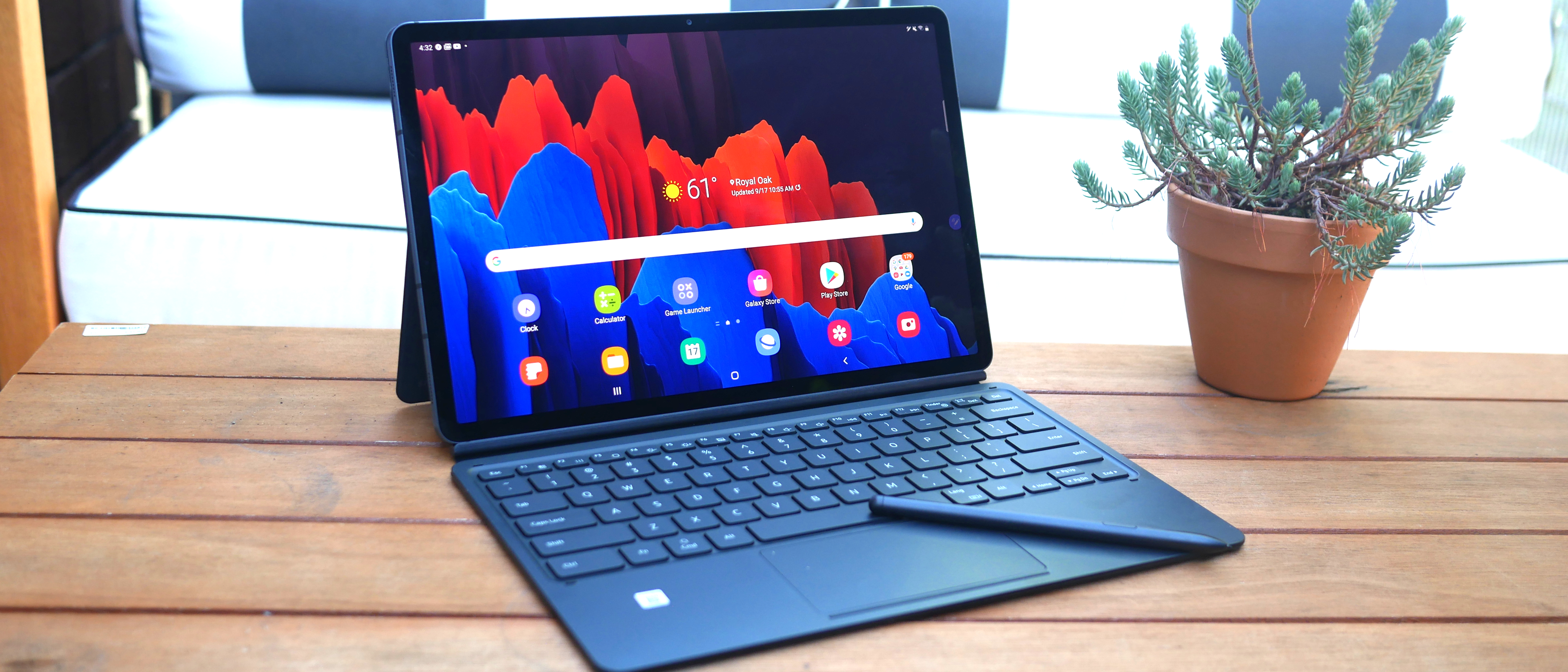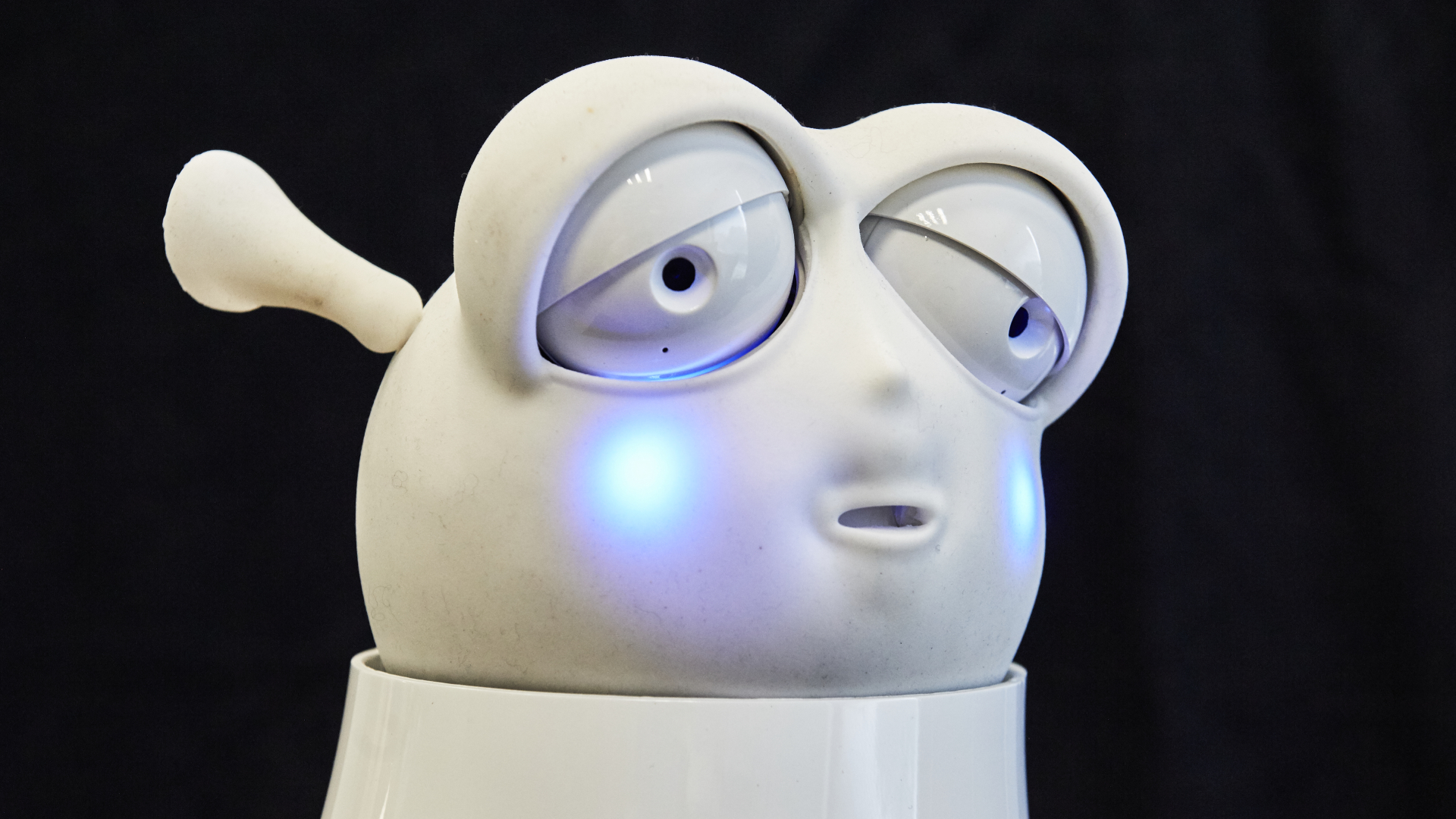Laptop Mag Verdict
With a larger display, new S Pen, improved Book Cover keyboard and 5G support, the Samsung Galaxy Tab S7 and Tab S7 Plus are compelling iPad alternatives.
Pros
- +
Magnificent OLED display
- +
Improved S Pen and Book Cover keyboard
- +
Great speakers
- +
5G support
Cons
- -
No headphone jack
- -
Some apps aren't optimized for tablets
- -
Below-average battery life (on Galaxy Tab S7 Plus)
- -
Expensive
Why you can trust Laptop Mag
Price: $729 (starting at $649)
CPU: Qualcomm Snapdragon 865+
RAM: 8GB
Storage: 256GB
Display: 11 inches (LTPS IPS LCD), 2560 x 1600-pixel
Battery: 13:08
Size: 10 x 6.51 x 0.25 inches
Weight: 1.1 pounds
The Galaxy Tab S6 was no fluke. Samsung has defied the odds once more with the Galaxy Tab S7 and Galaxy Tab S7 Plus, a duo of tablets mighty enough to go toe-to-toe with the iPad Air and iPad Pro. When I say "defied the odds," it's not only because the Galaxy Tab S7 and Tab S7 Plus run Android, but also because they're priced in the same premium range as the iPad Pro. And yet, the Galaxy Tab S7 and Galaxy Tab S7 Plus are tablets I can easily recommend to friends and family.
The larger version, despite subpar battery life, is the standout. Its successes are largely owed to the 12.4-inch, AMOLED display. The screen's vivacious colors and inky blacks are what makes the Galaxy Tab S7 Plus the ultimate tablet for media consumption — even more so than the iPad Pro and its impressive 12.9-inch Retina panel.
Price: $929 (starting at $849)
CPU: Qualcomm Snapdragon 865+
RAM: 8GB
Storage: 256GB
Display: 12.4 inches (SUPER AMOLED), 2800 x 1752-pixel
Battery: 8:51
Size: 11.22 x 7.28 x 0.22 inches
Weight: 1.3 pounds
New to the Galaxy Tab S7 line are a faster processor, 5G connectivity and a revamped S Pen (included in the box). Samsung also improved the external keyboard (sold separately) and outfitted the tablets with 120Hz displays. All of these changes make the Galaxy Tab S7 and Galaxy Tab S7 Plus a significant upgrade from the Tab S6, which they supplant as the best tablets running Android.
I know what you're wondering: but how do they compare to the iPad Air and iPad Pro? The answer? More favorably than you might expect.
Samsung Galaxy Tab S7 Plus pricing and configurations
Samsung's Galaxy Tab S7 starts at $649 for a Wi-Fi model with a Snapdragon 865+ chip, 6GB of RAM and 128GB of flash storage. Adding LTE brings the price up to $849.
If you don't need cellular connectivity, our Wi-Fi-only review unit with 8GB of RAM and 256GB of UFS 3.0 storage costs $729 while a 512GB model goes for $829.
The Samsung Galaxy Tab S7 Plus starts at $849 and comes equipped with a Qualcomm Snapdragon 865+ chip, 6GB of RAM and 128GB of UFS flash storage.
If you need more storage and RAM, our review unit has 8GB of memory and a 256GB flash drive for $929 while a 512GB version goes for $1,029.
Adding 5G connectivity increases the price of the base model to $1,049 on Verizon, T-Mobile and US Cellular.
Samsung Galaxy Tab S7 / Tab S7 Plus design
The Galaxy Tab S7 and Galaxy Tab S7 Plus share a similar design DNA as their predecessor, the Galaxy Tab S6. From the front, the Galaxy Tab S7 tablets look like most premium slates except with thin display bezels similar to the iPad Pro and new iPad Air. This allows you to focus on the larger display without being distracted by thick black bars.
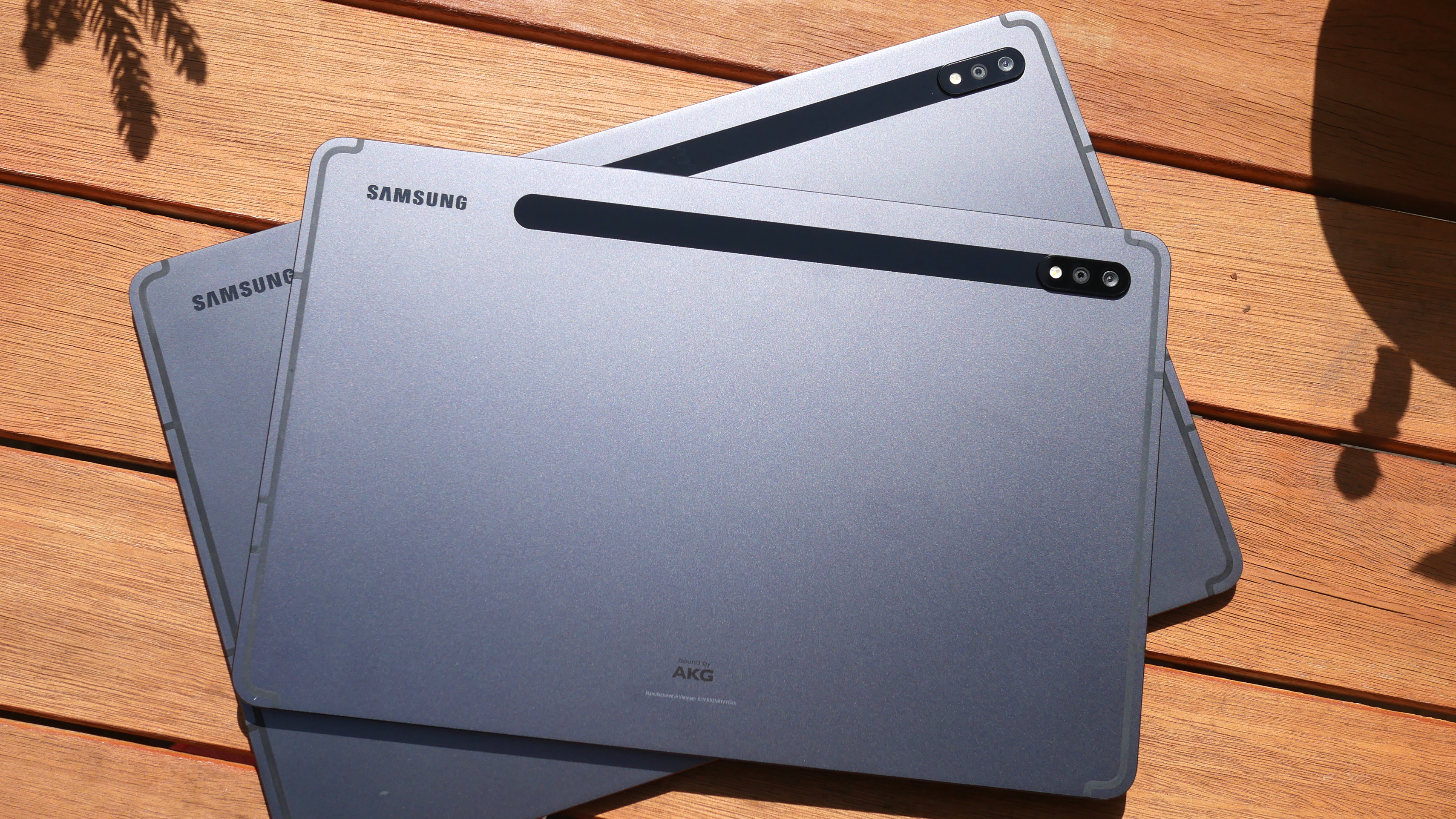
The only change Samsung made to the front of the Galaxy Tab S7 line was moving the selfie cam to the longer edge of the tablets so you can take shots in landscape mode when connected to the keyboard.
When I flipped the Galaxy Tab S7 around, the first thing I noticed was the stealthy Mystic Black color, which looks sleek and expensive. As much as I like the dark tone, I'm bummed Samsung shifted from vibrant colors to more muted hues. Hopefully, the Mystic Silver and Mystic Bronze options add more excitement than the fairly standard black.
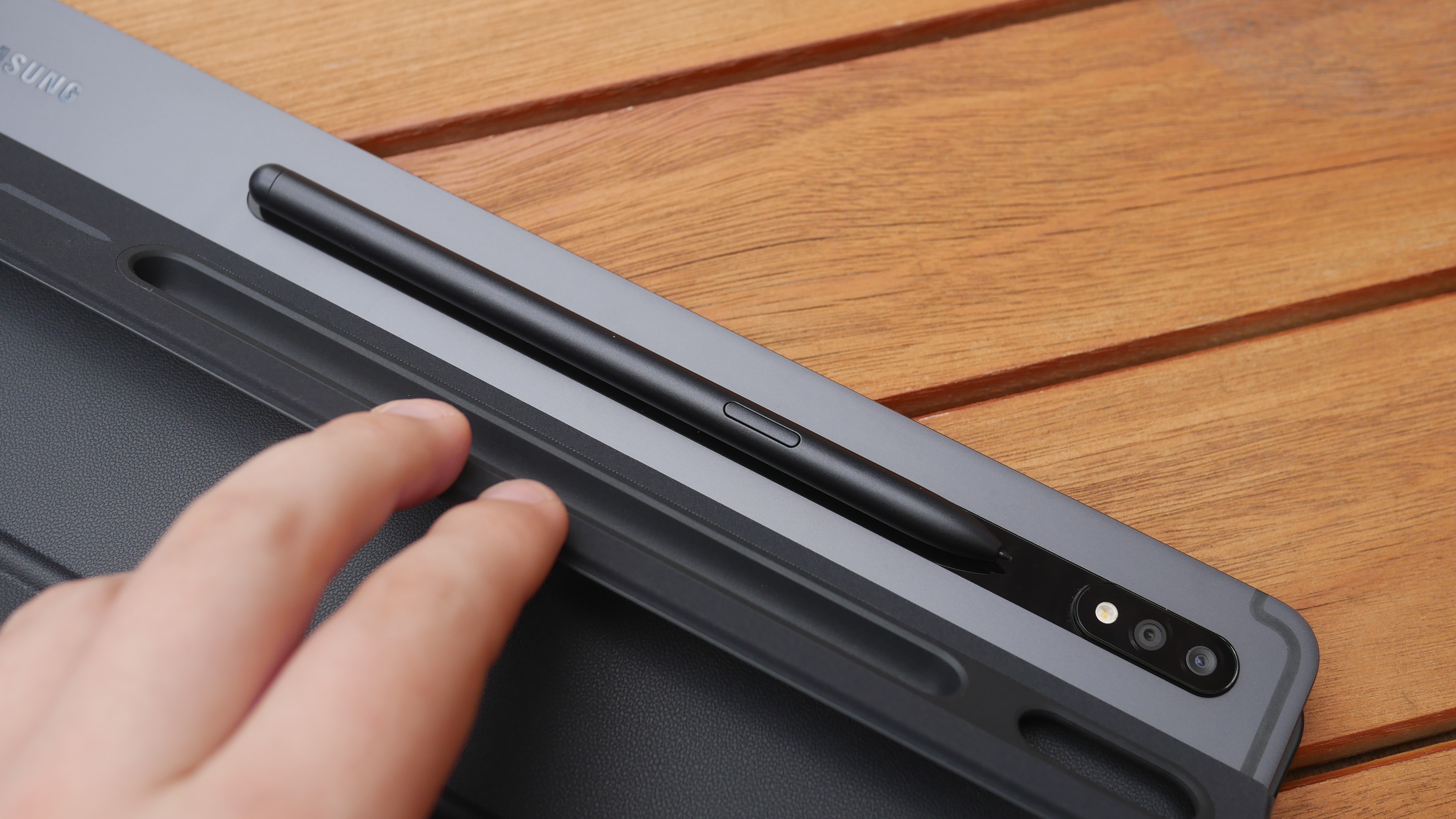
Also on the back is a glass teardrop-shaped magnetic stylus holder that extends from beneath a dual-camera module. This replaces the magnetic groove Samsung used on the Galaxy Tab S6 to house the stylus when it's not in use. The magnet was strong enough to hold the S Pen in place as I rapidly shook the tablet, however, any physical contact with the stylus can dislodge it from the strip. If you're worried about losing the pen, you should consider the detachable keyboard (more on that later).
Otherwise, there are some antenna bands on the back of the tablet and the edges have an attractive brushed finish to them. A single USB 3.2 Type-C charging port resides on the bottom of the Galaxy Tab S7 and Galaxy Tab S7 Plus, but there is sadly no headphone jack on either unit.
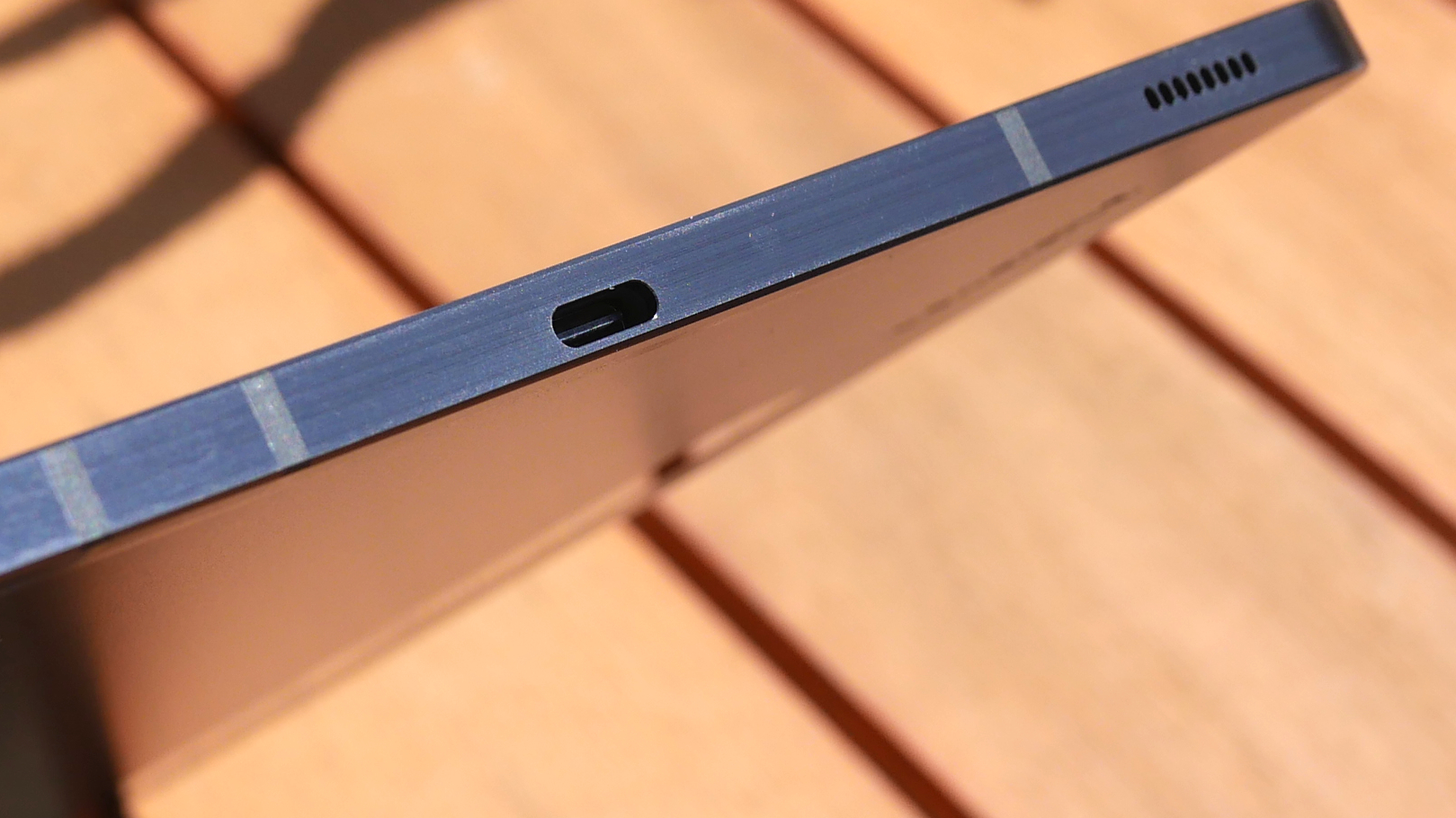
At 11.2 x 7.3 x 0.2 inches and 1.3 pounds, the Galaxy Tab S7 Plus is thin and lightweight. For reference, it has a smaller footprint than the 12.9-inch iPad Pro (11.0 x 8.5 x 0.23 inches, 1.4 pounds) and is a tad lighter. The Galaxy Tab S7 is considerably smaller than the "Plus" variant, coming in at 10 x 6.5 x 0.25 inches and 1.1 pounds. Measuring 0.3 inches thin and weighing 1.7 pounds, the Surface Pro 7 is the least portable of the bunch.
Samsung Galaxy Tab S7 / Tab S7 Plus display
"Ohhh, so this is why you'd buy the Galaxy Tab S7 Plus over the iPad Pro," I realized after powering the tablet on. The 12.4-inch, 2800 x 1752-pixel Super AMOLED panel is simply breathtaking — and that's an adjective I don't use lightly.
Don't get me wrong, the 11-inch, 2560 x 1600-pixel LTPS TFT display on the Galaxy Tab S7 is no slouch, either. In fact, it gets brighter than the S7 Plus' panel and color vibrancy is also excellent, if not up to the OLED standard. The gap in quality between the two displays was closer than I expected, but the Galaxy Tab S7 Plus' screen has a bit more pop and noticeably darker black levels. More importantly, that extra 1.4 inches of diagonal screen real estate makes a huge difference.
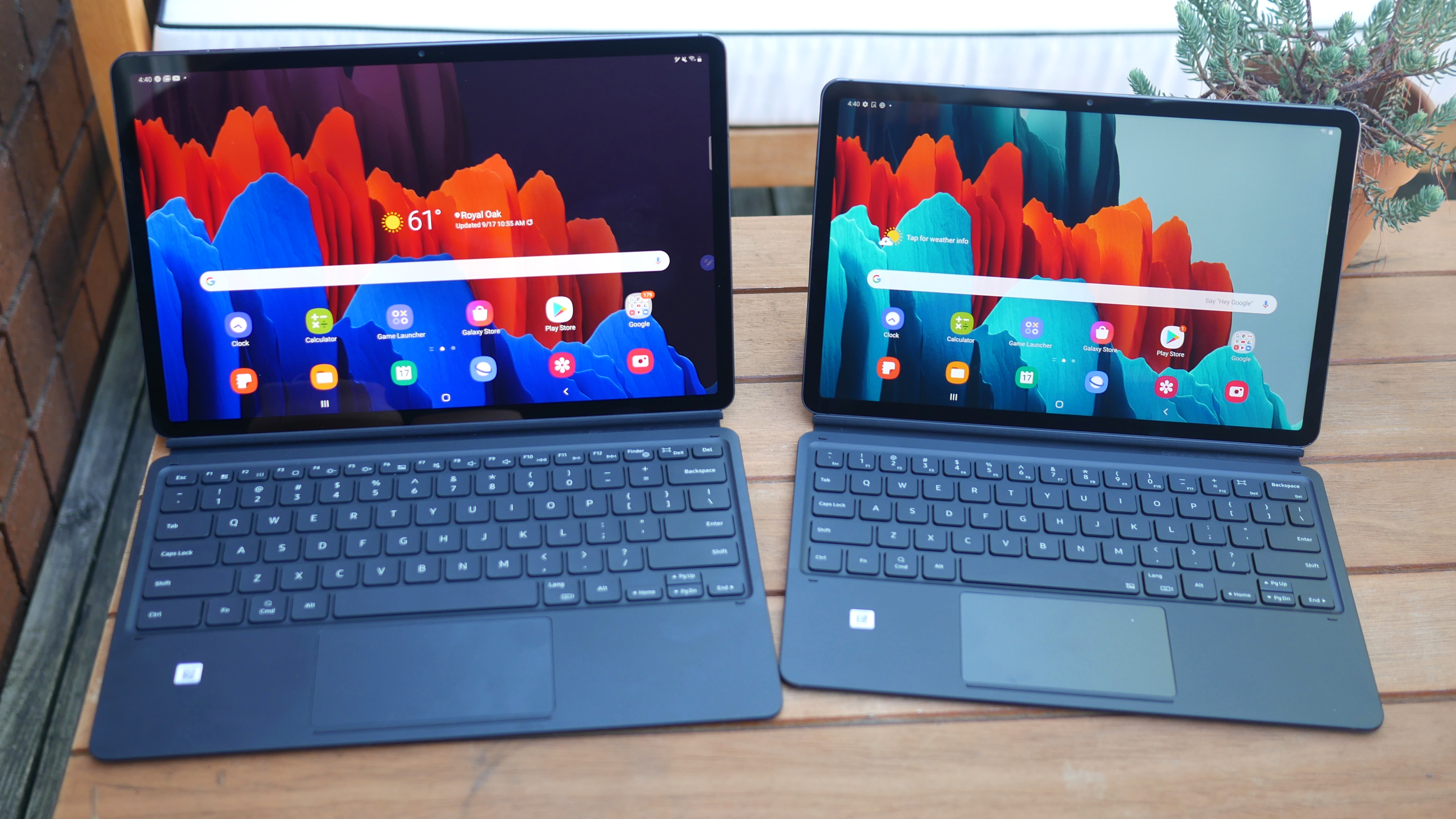
The stunning display is without question my favorite thing about the Galaxy Tab S7 Plus. It gives you a good reason to buy this tablet over the competition or its smaller counterpart. Tablets, after all, were developed primarily for media consumption and no display does a better job of showcasing content than this one.
I could see each of the subtle ridges running across Rami Malek's scarred face in the trailer for No Time to Die. Daniel Craig's blue eyes glistened like aquamarine gemstones in stark contrast to the fiery oranges that erupted from the panel during a missile launch scene. And because this is an OLED display, dark scenes and objects appeared as a true inky black.
It wasn't just the photos and videos that looked great, the panel is so saturated that my eyes were drawn to every object, whether it was webpages or app icons. I've come across only a few laptop displays with the same brilliant colors, but there is something special about holding this one in your hand.
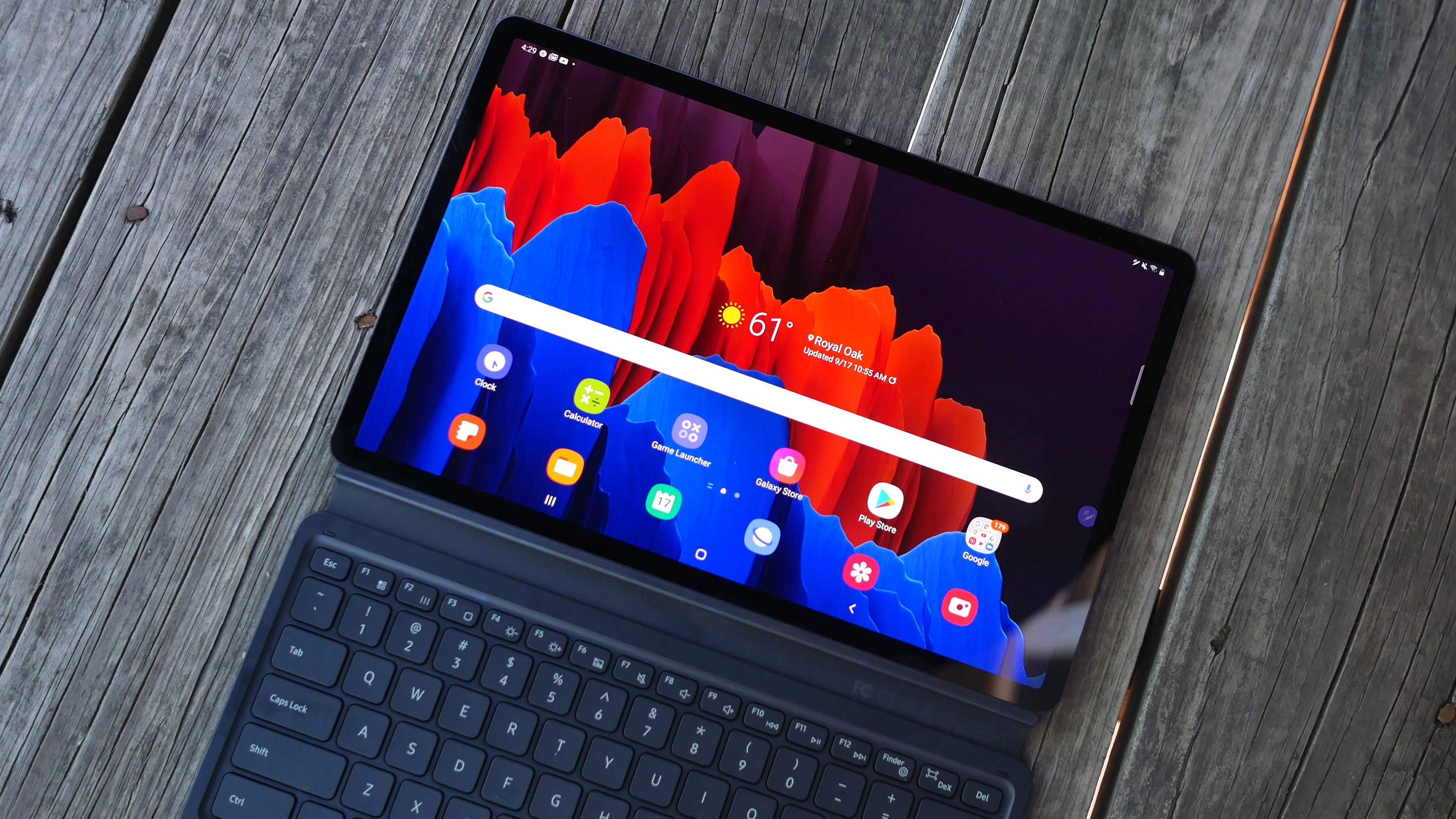
The panel is also very sharp, so you'll see even the smallest details in videos and photos. On top of that, it has a 120Hz refresh rate (as does the Galaxy Tab S7), which means animations look and feel silky smooth. Another spec worth noting is the 16:10 aspect ratio; the screen is slightly taller than a traditional laptop or tablet screen but still wider and narrower than the 4:3 ratio on the iPad.
According to our colorimeter, the Galaxy Tab S7 Plus' screen covers 210.6% of the sRGB color gamut in Vivid mode, making it much more vibrant than the 12.9-inch display on the iPad Pro (123%) and the Surface Pro 7's 12.3-inch panel (102%). Even the Galaxy Tab S7's LCD screen is more colorful, hitting 152.4% and easily topping the 108% category average.
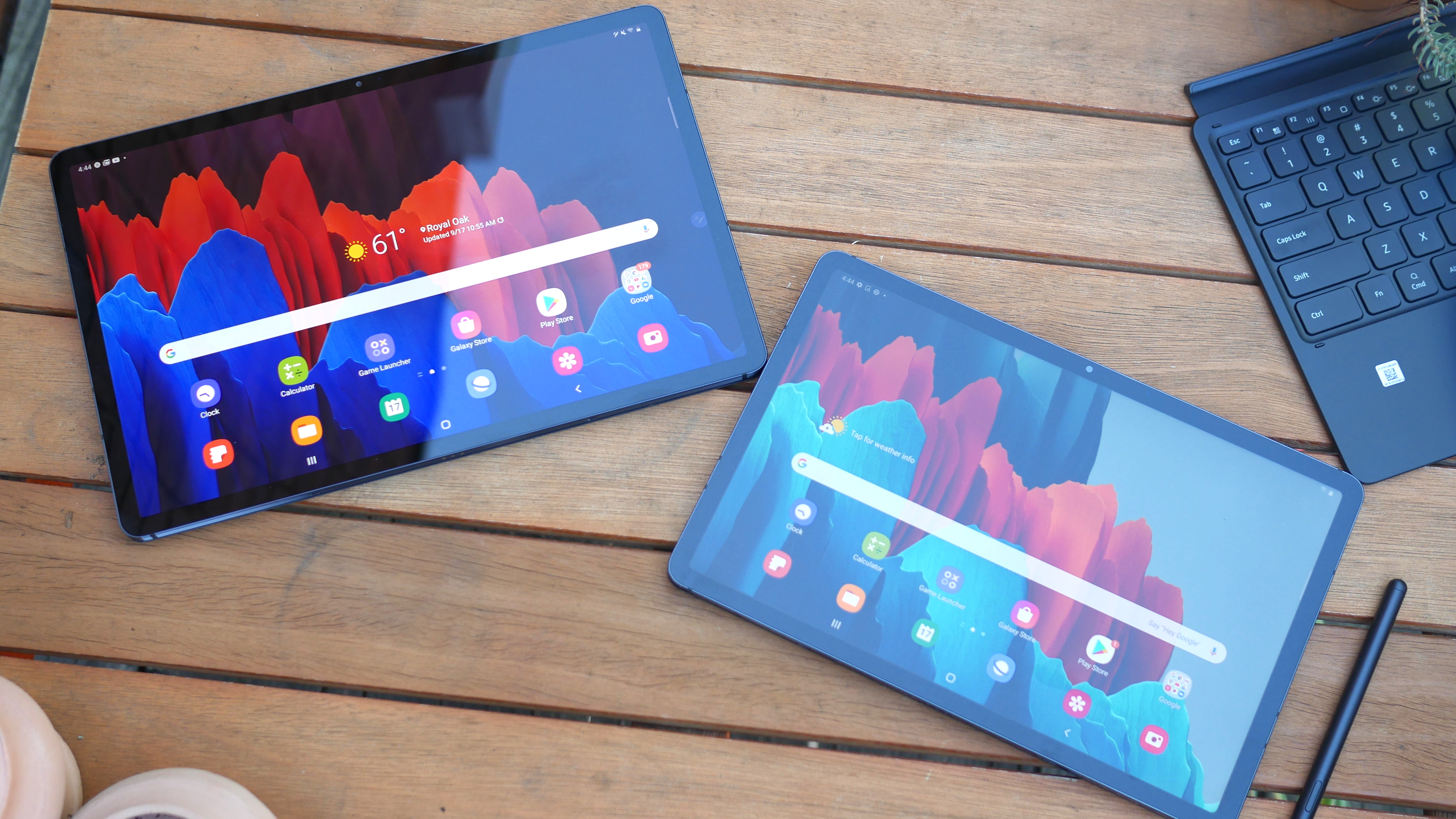
You won't have issues viewing either of these tablets outside on a sunny day. The Galaxy Tab S7 Plus' screen illuminates to 430 nits, while the Galaxy Tab S7's screen hit a resounding 499 nits. As bright as they are, the iPad Pro gets even brighter, reaching 559 nits, easily outshining the 442-nit tablet average and the Surface Pro 7 (395 nits).
Embedded in the Galaxy Tab S7 Plus' display is a fingerprint sensor for logging in. It's pretty quick, but not as reliable as I would have liked, so I ended up using facial recognition login via the IR camera and used the fingerprint sensor as a backup. The IR camera is generally faster and more reliable than the finger scanner, but I still didn't get a 100% success rate.
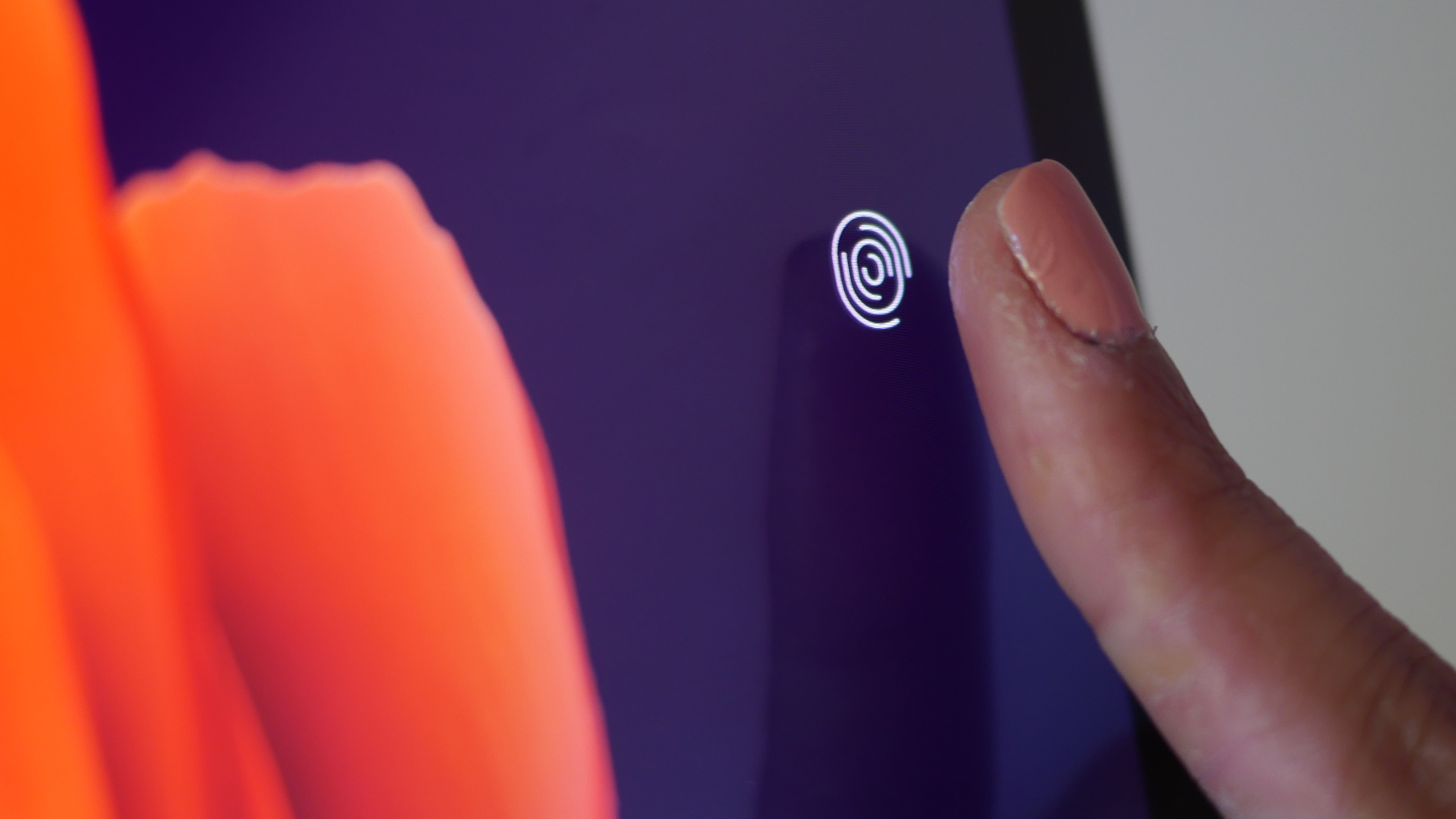
Unlike the Galaxy Tab S7 Plus, the Tab S7's fingerprint sensor is embedded in the side-mounted power button. It's not as easy to find, but I had more luck using this physical sensor than the one hidden beneath the Tab S7 Plus' OLED panel.
Samsung Galaxy Tab S7 / Tab S7 Plus S Pen and Book Cover keyboard
Samsung revamped the S Pen, making it more responsive and accurate so artists can feel instant feedback as they drag it across the Tab S7 and Tab S7 Plus' touchscreens. A favorite feature of Galaxy Note loyalists, the new S Pen achieves these goals with reduced latency from 42 milliseconds to 9 ms.
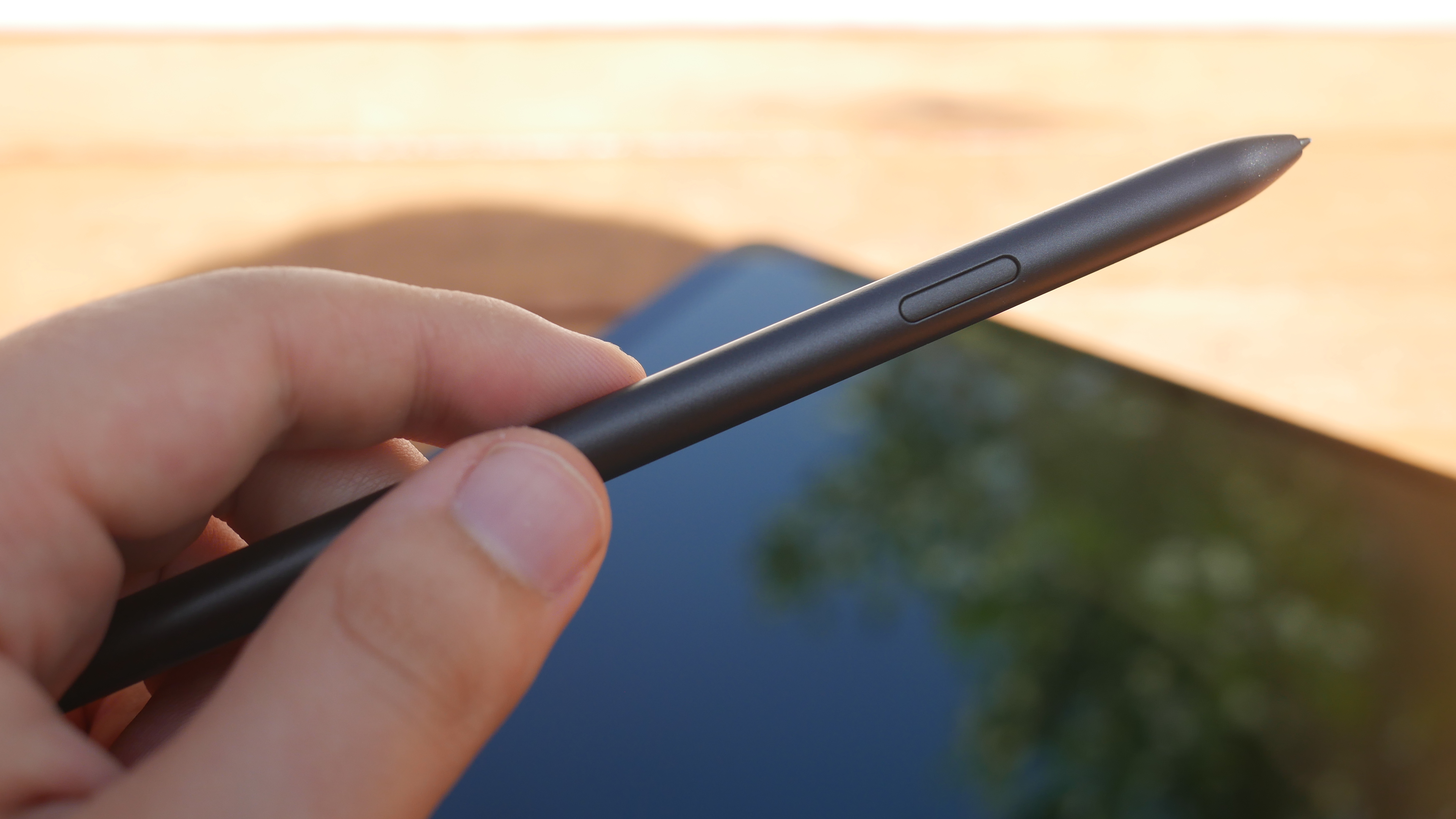
The updated stylus is also a bit thicker, which makes it more comfortable to hold, although I still find it too thin for my chubby fingers. And finally, Samsung added Air Gestures, similar to the ones supported on the Galaxy Note 20. The gestures were difficult to execute at times and felt gimmicky even when they did work.
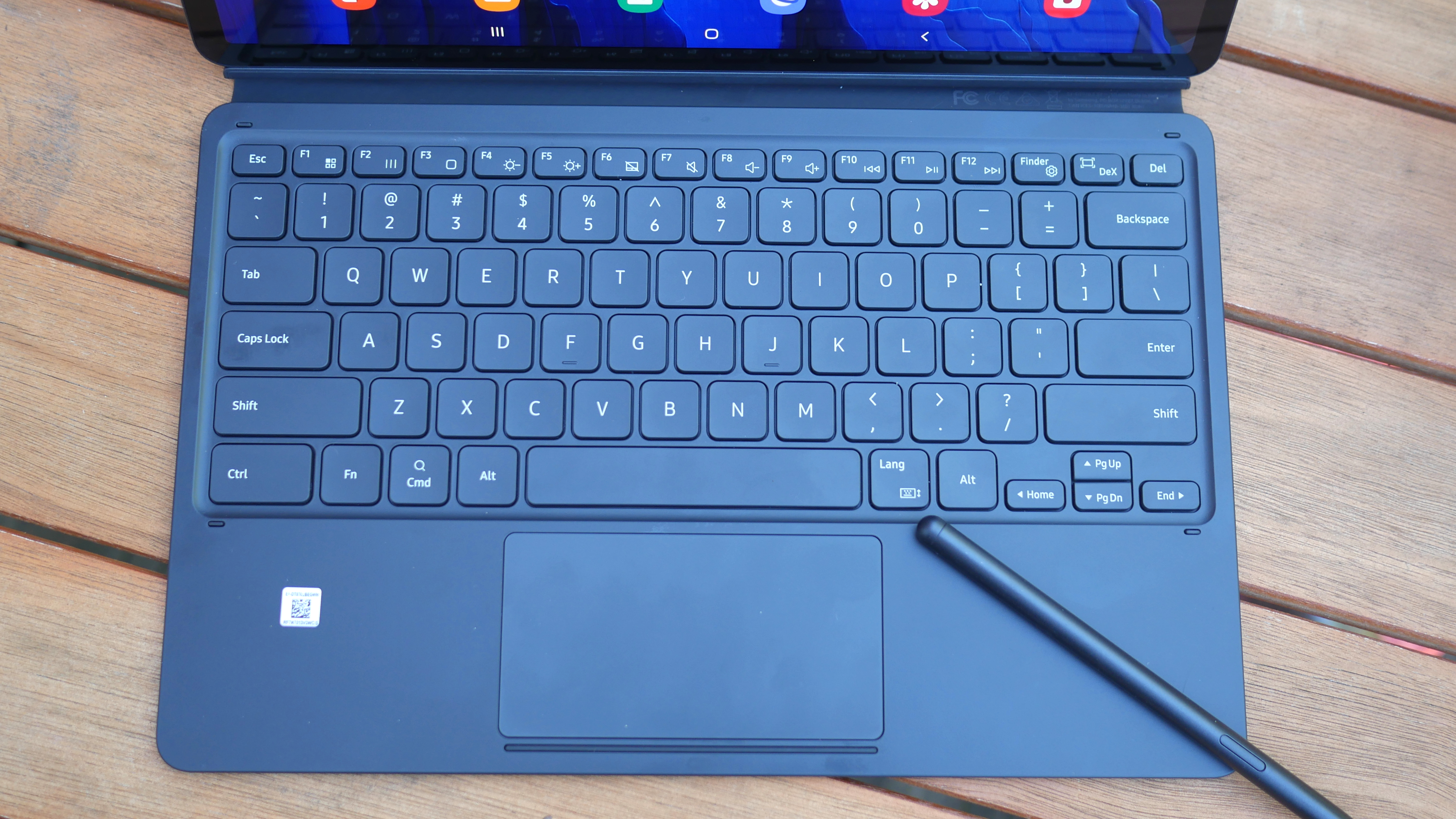
The stylus kept up with my fast swipes and rapid taps as I browsed the web and drew a picture in the included PENUP app. Not only should Samsung earn praise for improving the pen, but it wins points for even including the S Pen in the box. Most competitors charge extra for a stylus (I'm glaring at you, Microsoft and Apple). I also like how the S Pen charges when placed on the Galaxy Tab S7 and Tab S7 Plus' magnetic strip.
When you want to use the Galaxy Tab S7 Plus as a laptop, you can connect it to the optional keyboard attachment. Also updated this year, the new Book Cover keyboard has a larger touchpad that supports multi-touch gestures, a delete key, function keys and full-sized Enter and Shift keys. The keys are surprisingly comfortable to type on and the trackpad works well, but don't expect deep key travel.
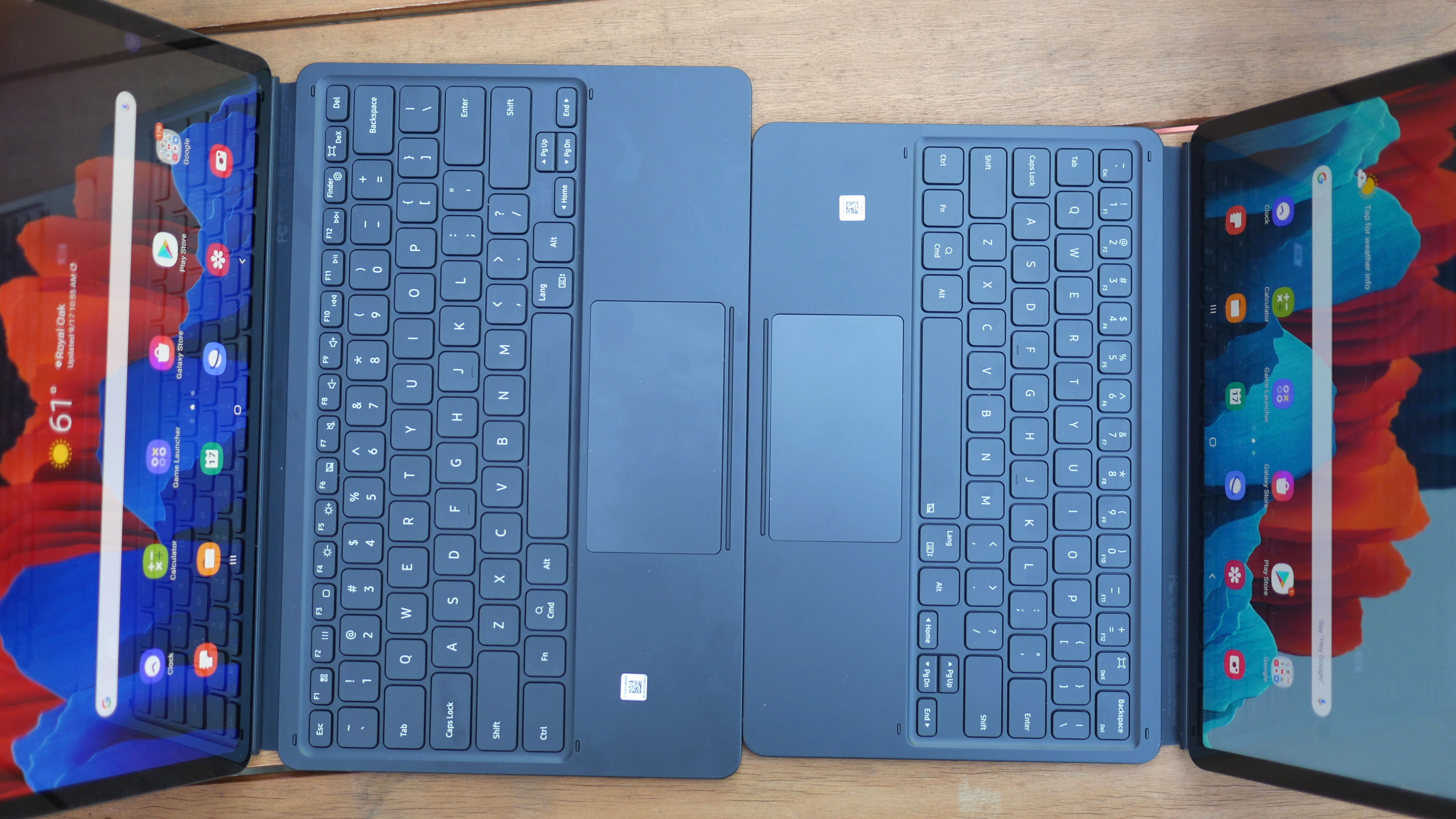
The Galaxy Tab S7 wasn't so lucky. Its Book Cover keyboard attachment is cramped, lacks a shortcut row and has several undersized keys, including Enter and Backspace. I could see myself using the Tab S7 Plus' keyboard for work, but I can't say the same about the keyboard on the smaller model.
Separate from the keyboard attachment is a leatherette folio cover that protects the back of the Galaxy Tab S7 and Tab S7 Plus. It feels great and has a clever flap on the top under which the stylus is encased. This protects the stylus when it's not in use but keeps the pen readily accessible.
Android 10 and Samsung DeX
The Galaxy Tab S7 and Tab S7 Plus run Android 10 out of the box, making them the last species of a near-extinct line of Android tablets. It looks like a larger version of what you find on the latest Android phones complete with the millions of apps available on the Play Store (an advantage the Galaxy Tab S7 has over the Surface Pro 7). Unfortunately, certain Android apps and interfaces don't scale well on a tablet — large black bars flank the usable screen space on un-optimized apps.
Samsung knows Android is an Achilles' heel for those who want to do more than consume content, so it brought back DeX after a hiatus on the Tab S6 Lite. For the uninitiated, DeX is Samsung's custom desktop interface designed to make the Tab S7 Plus feel more like a laptop so you don't have to stop using your tablet when it's time to get some work done.

The main DeX interface will look familiar to those who have used a Windows 10 PC or Chromebook. There is a taskbar at the bottom of the screen where you can pin apps, otherwise, they stay as shortcuts on the home screen. Similar to Windows 10, the bottom-right corner is where you'll find quick access icons for certain settings, like Bluetooth, Wi-Fi and date/time.
I spent most of my time in the standard Android mode but switched to DeX when I attached the Book Cover keyboard. It plays better with the touchpad, although some apps refused to open in DeX mode and resizing the windows is more difficult than it needs to be.
There are some nice new additions to DeX this time around. For one, the Book Cover Keyboard now has a DeX key so you can instantly launch the desktop interface with a single tap. And just like the Galaxy Note 20, DeX on the Tab S7 can be wirelessly cast to a TV so long as it supports Miracast.
Samsung Galaxy Tab S7 / Tab S7 Plus performance
Powering our Galaxy Tab S7 and Galaxy Tab S7 Plus is a Qualcomm Snapdragon 865+ chip, the same one found in the Galaxy Note20 and Note20 Ultra. Along with 5G support, the chip delivers faster performance than the Snapdragon 855 found in the Galaxy Tab S6.
Our tablets, which packed 8GB of RAM, never slowed down during my testing. The Tab S7 and Tab S7 Plus ran multiple apps at once and seamlessly switched between DeX mode and the standard Android 10 interface without a hitch. I played music on YouTube Music, watched videos on YouTube and ran simple apps, like AccuWeather, without experiencing any performance issues.
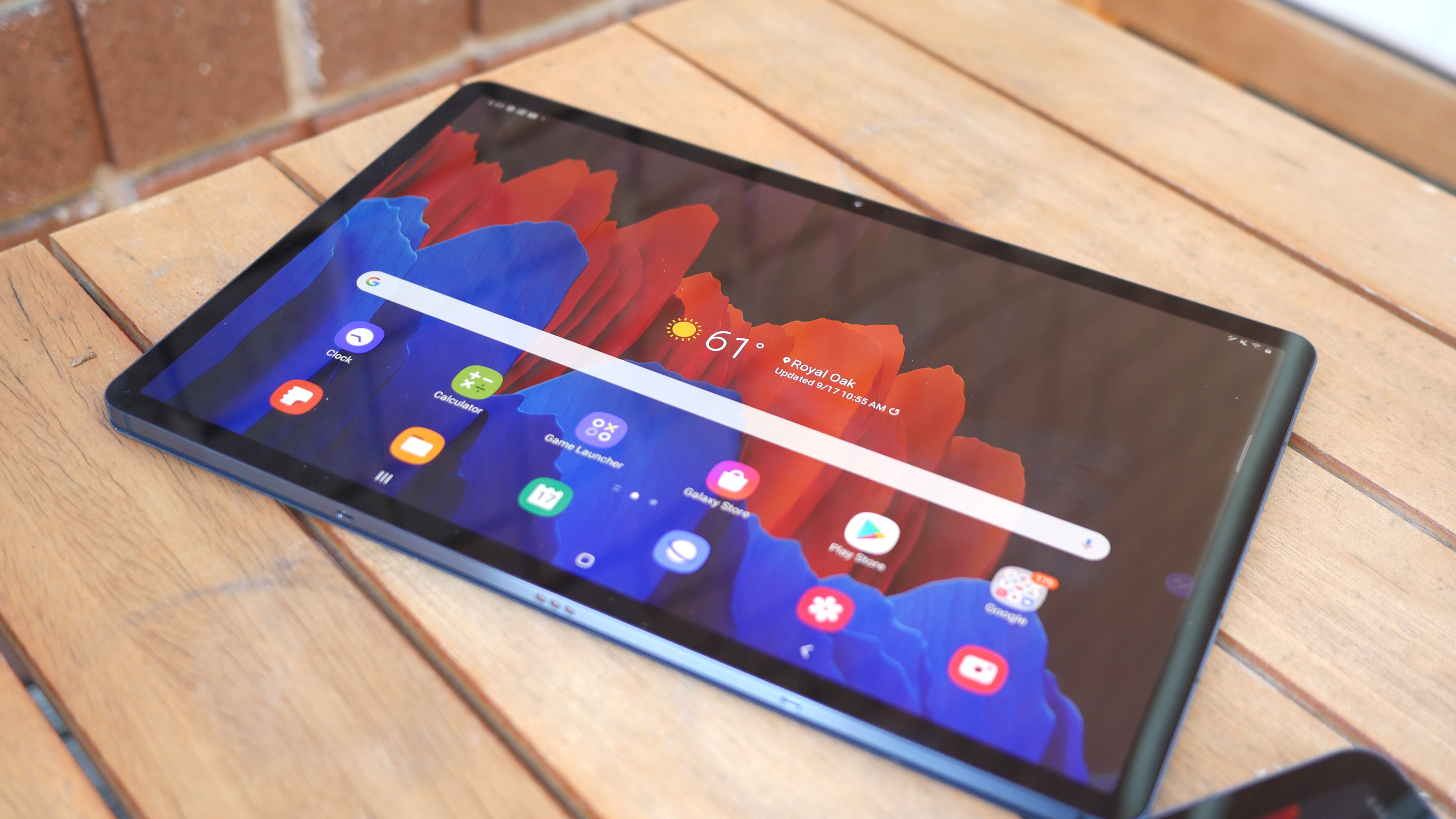
Yes, your tablet will slow down if you forget to close background tasks or load a few too many Chrome tabs, but the majority of tablet users will be pleased with the performance of the Galaxy Tab S7 and Tab S7 Plus.
The Galaxy Tab S7 didn't light-up our benchmark tests, and that's OK. While it's not as brawny as its rivals, the Galaxy Tab S7 runs Android and, therefore, doesn't need to lift as much weight. So although the below scores might not sound promising, the Tab S7 performs well in everyday scenarios.
With that said, the Galaxy Tab S7 and Galaxy Tab S7 Plus notched a 3,074 and 2,910, respectively, on the Geekbench 5 overall performance test. Those figures pale in comparison to the iPad Pro (4,720, A12Z CPU) and Surface Pro 7 (4,878, 10th Gen Core i7).
Samsung Galaxy Tab S7 / Tab S7 Plus 5G
The Galaxy Tab S7 Plus supports a 5G connection, so you should get the fastest cellular speeds around if you're in a 5G-covered area. As of now, 5G is pretty limited and only a few wireless carriers have a live network.
We tested Verizon's 5G network with the Lenovo Flex 5G and determined it to be wildly unreliable, but promising nonetheless. Most people don't buy a new tablet every year so getting one with 5G today means you won't be missing an important feature tomorrow (and by that I mean in the next few years).
Samsung Galaxy Tab S7 / Tab S7 Plus audio
The Tab S7 Plus' quad-speaker setup pumps out rich, loud audio. My wife and I watched an episode of Project Runway on the Galaxy Tab S Plus and only needed to listen at around 60% volume to hear Heidi Klum's harsh critiques clearly.

And when I streamed music on YouTube Play with Dolby Atmos turned on, my favorite songs sounded surprisingly balanced and full-bodied. When Glass Animals' "Domestic Bliss" rose to a crescendo, the lead singer's vocals remained undistorted despite being loud enough to hear from the other side of my apartment. The treble was sharp at maximum volume, but it rounded off when I dialed the sound down to 70%.
What impressed me the most was how hefty the drums sounded in Hozier's "Dinner & Diatribes." It might not be the heart-thumping slams of a proper Bluetooth speaker, but the thuds were much heavier than I'm used to hearing from a tablet. My only complaint is that the speaker grills on the side are easy to block with your palms when you hold the tablet in landscape mode.
Samsung Galaxy Tab S7 / Tab S7 Plus cameras
As for the cameras, the Galaxy Tab S7 and Galaxy Tab S7 Plus have a 13MP main camera and a 5MP secondary ultra-wide lens. On the front is an 8MP selfie camera.
I took a few quick shots around my house and outside on my porch and the photos turned out great.
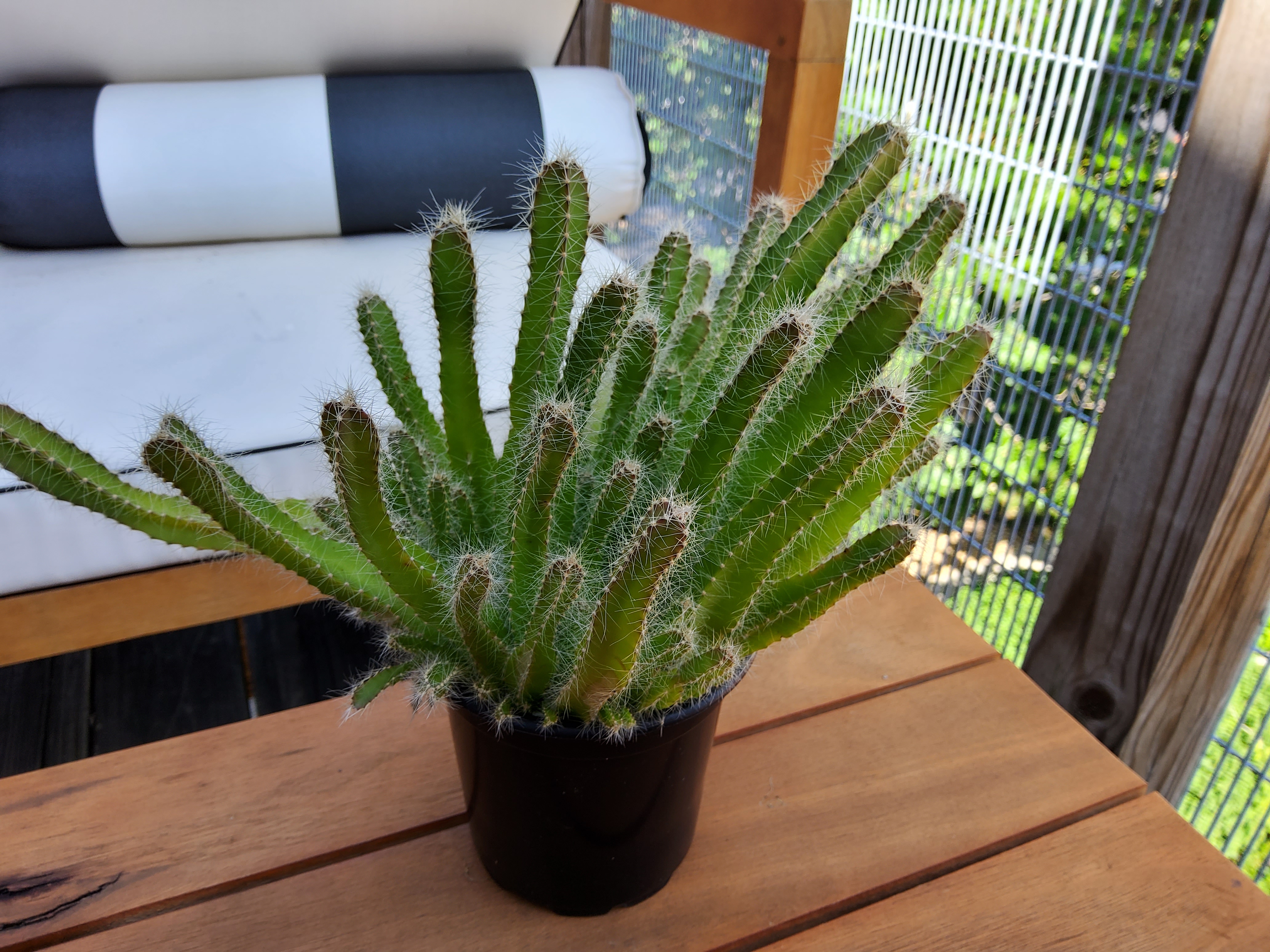
This first shot shows the macro capabilities of the 13MP lens. You can see each individual thorn shooting out of the fingers of my young dragonfruit plant. The image retained its detail even when I zoomed in.
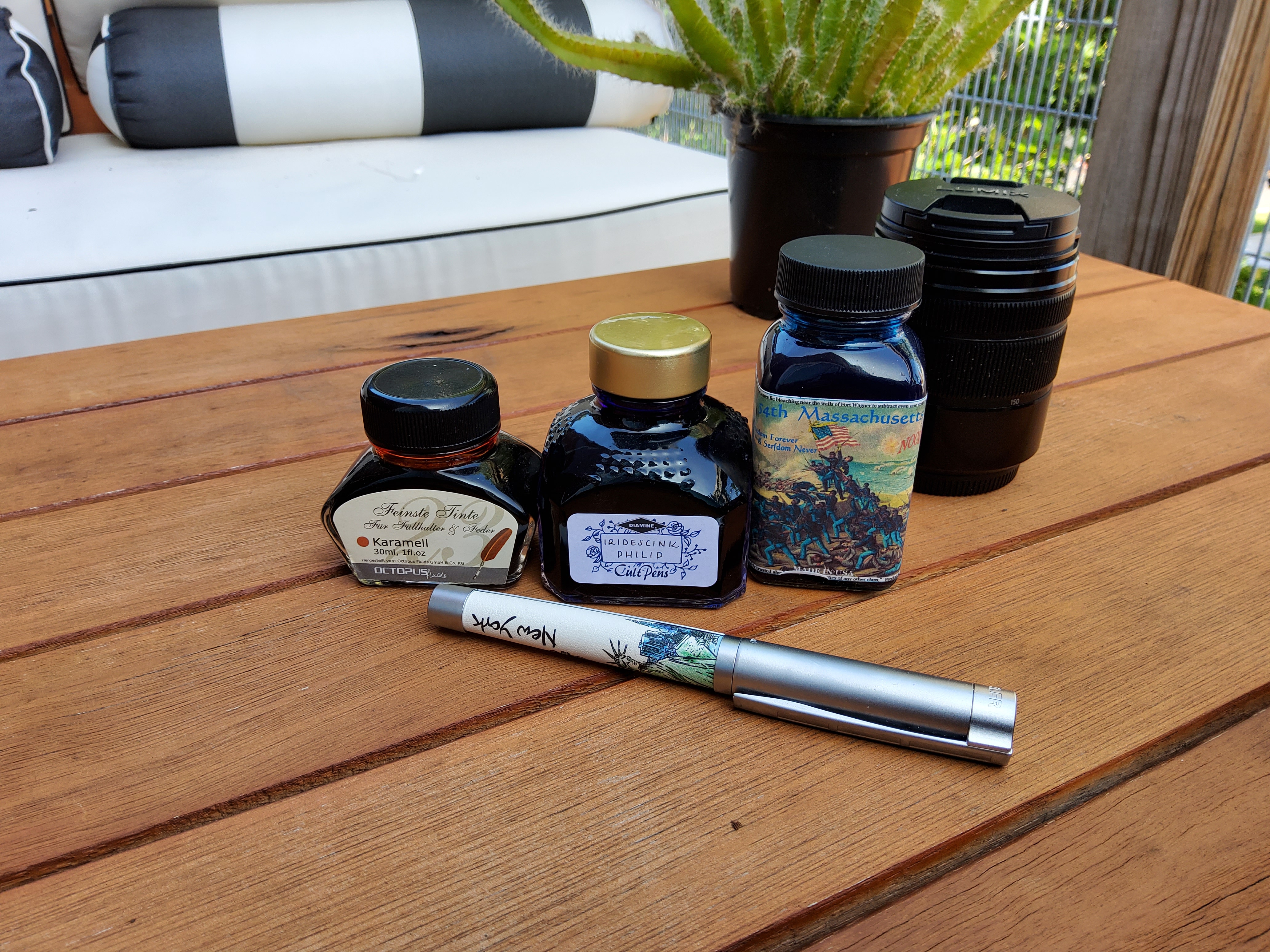
Again, this picture of ink bottles is very sharp. You can read the smaller cursive font on the left bottle and even the tiny letters at the top of the right-most bottle. Color accuracy is great and if look closely, you can see the leather finish on the fountain pen in the front.
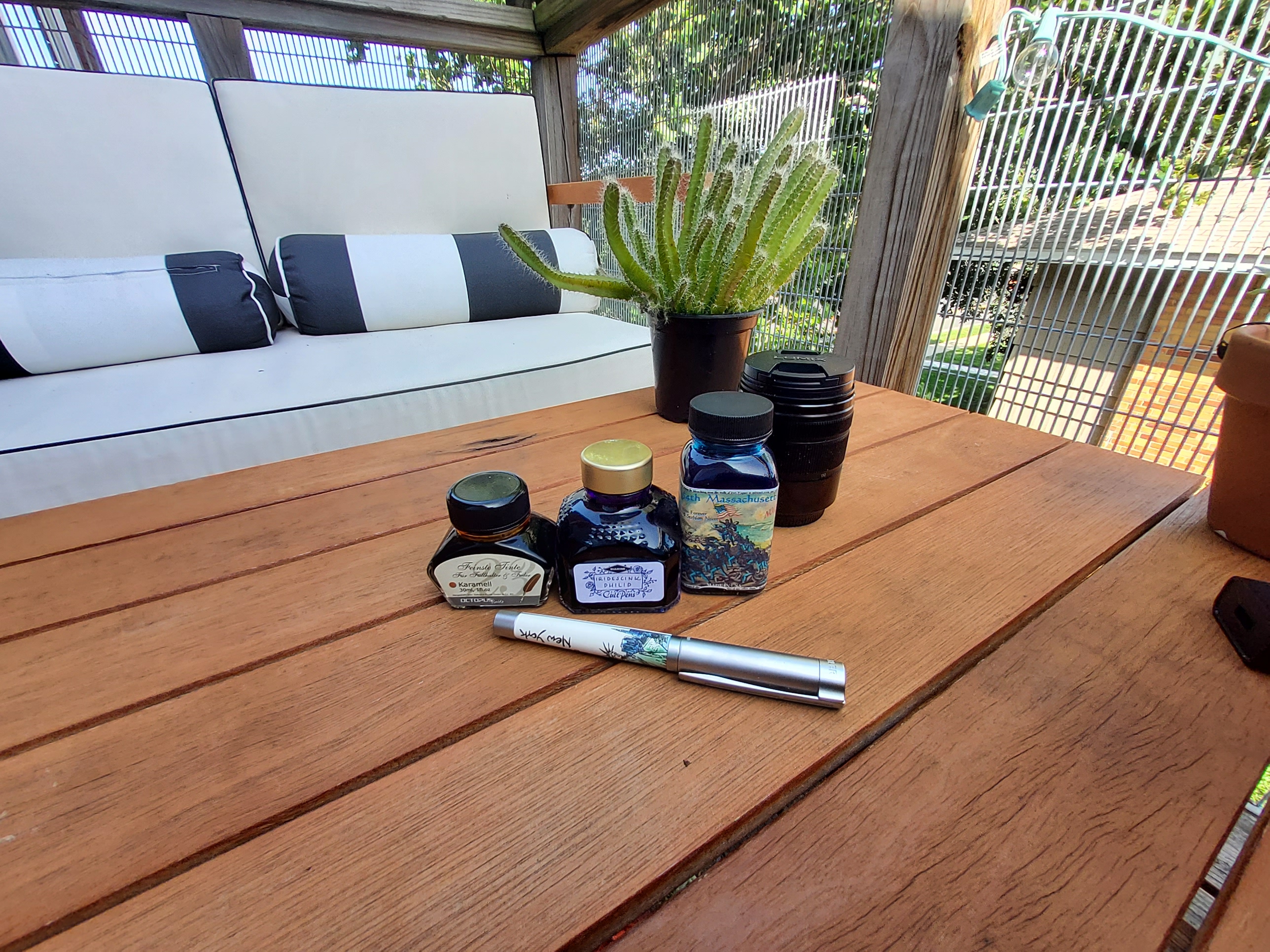
The wide-angle shot is less impressive. There is some obvious distortion similar to what you find on a fisheye lens. The 5MP also struggled to capture as much detail — it's good enough for Facebook but I wouldn't get this image printed.
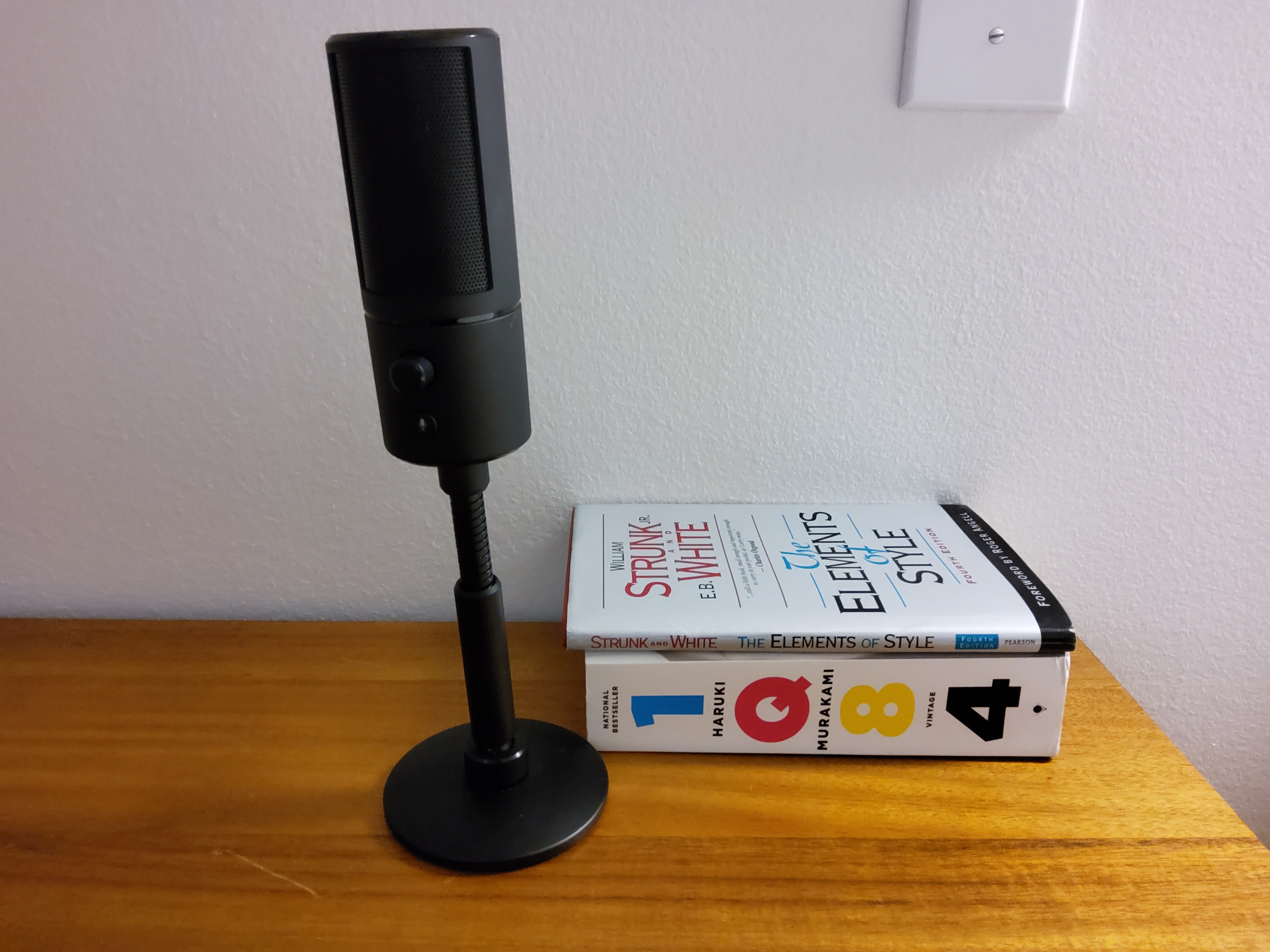
There is no dedicated Night Mode option, but the Galaxy Tab S7 did a good job of capturing light in darker environments, like in this picture of the books I'm currently reading.
Other shots I took were, in typical Samsung fashion, oversaturated. The dull green leaves of a changing fall tree looked like they had just been given a fresh coat of paint while the sky above was a deep blue instead of a bluish-gray. Some people will prefer the amped-up colors, but purists should download a photo editing app to tone them down.

The selfie I snapped with the 8MP front-facing camera reminded me that my work-from-home days during the pandemic have taken a toll on my personal hygiene. Stray strands of hair in my beard are ready for a razor; the lens was so sharp that I could see reflections in my eyes.
Samsung Galaxy Tab S7 / Tab S7 Plus battery life
Up to this point, the Galaxy Tab S7 Plus justified its higher price with a larger, more colorful display and more practical keyboard than the Tab S7. Here is where the script flips.
The Galaxy Tab S7's 8,000 mAh battery lasted for an impressive 13 hours and 8 minutes on our battery test, which involves continuous web surfing over Wi-Fi at 150 nits of brightness.
Despite having a larger 10,090 mAH cell, the Galaxy Tab S7 Plus powered down after only 8 hours and 51 minutes on the same test. We ran this test a few times to be sure but never got close to the 10:56 average. In comparison, the iPad Pro lasted for 10 hours and 16 minutes while the Surface Pro 7 endured for a paltry 7 hours and 20 minutes.
We'll continue to run more battery life tests on the Galaxy Tab S7 Plus and will update this review should anything change.
Bottom line
If you'd asked me a few years ago which Android tablet to buy, I'd probably have said to stop looking. Buy an iPad. Buy a Surface Pro. Buy anything else. If you ask me today, the Galaxy Tab S7 and Galaxy Tab S7 Plus are the clear-cut best options. They both have gorgeous displays, premium designs, top-notch accessories, and even 5G support for those who need the fastest internet speeds outside of the home.
I'd go as far as to say the Galaxy Tab S7 Plus is the best tablet for viewing media due in large part to its magnificent 12.4-inch OLED display, which makes regular LED panels look dull. For productivity, the iPad Pro is still the best choice. While the Galaxy Tab S7 Plus adds nice improvements to the keyboard and S Pen, the combo of Android and DeX remains a thorn in its side for those who want their tablet to be a primary device.
So, who should buy the Galaxy Tab S7? If you want a tablet for watching Netflix, streaming videos, drawing, or even light productivity, the Galaxy Tab S7 and Tab S7 Plus are excellent options. This is especially true if you're not locked into Apple's ecosystem because the excellent iPad Pro and upcoming iPad Air are hard to ignore.
Phillip Tracy is the assistant managing editor at Laptop Mag where he reviews laptops, phones and other gadgets while covering the latest industry news. After graduating with a journalism degree from the University of Texas at Austin, Phillip became a tech reporter at the Daily Dot. There, he wrote reviews for a range of gadgets and covered everything from social media trends to cybersecurity. Prior to that, he wrote for RCR Wireless News covering 5G and IoT. When he's not tinkering with devices, you can find Phillip playing video games, reading, traveling or watching soccer.
